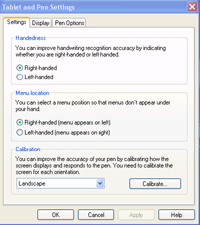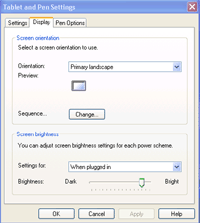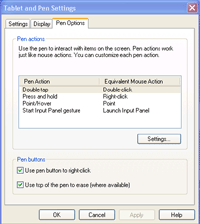The Tablet PC: An in depth look with the FIC SlateVision
by Matthew Witheiler on December 12, 2002 7:43 AM EST- Posted in
- Laptops
Windows XP Tablet Edition
The foundation behind every new Tablet PC on the market is Microsoft's newest operating system: Windows XP Tablet PC Edition. What are the differences between Windows XP Tablet PC Edition and the well known Windows XP Professional operating system? There actually are not that many.
Windows XP Tablet PC Edition is based on Windows XP Professional, much like Windows XP Media Center Edition is. This means that Windows XP Tablet PC Edition maintains the full functionality of Windows XP Professional, including the advanced networking functions of the operating system. In fact, the majority of differences come with the software that the operating system includes, namely Microsoft Windows Journal, Microsoft Input Panel, and Microsoft Sticky Notes. We will get into detail about these applications in a moment but for now let's examine the operating system level differences between Windows XP Tablet PC Edition and Windows XP Professional, of which there is only one.
Besides the bundled Tablet PC specific applications and tutorials, there is really one noticeable difference between Windows XP Tablet PC Edition and Windows XP Professional (besides the boot screen logo that is). That difference is the inclusion of a "Tablet and Pen Settings" icon in the control panel. Via this control panel. function, one can set the the tablet properties. A wizard actually runs after installation of the operating system to guide the user through setting the various tablet options, but the control panel option allows for easy control of the settings. A glimpse of this panel reveals the complex underlyings of the Tablet PC operating system.
The first page of the settings dialogue box provides three tablet options. The first of the three allows the user to indicate whether he or she is left or right handed. How the tablet alters its recognition by knowing the user's hand preference is not something that Microsoft is willing to go into detail about, but the option does indicate that there has been a lot of fine tuning in the handwriting recognition software (which we will get to try out in just a bit). The second option on this page allows the user to set where pop-up menus are located. In a standard Windows XP Professional install, right clicking the mouse creates a menu that spawns to the lower left of the mouse cursor. In a tablet, this menu location would be fine for left handed users but right hand users would face the problem of having their hand cover up the newly spawned menu. This problem is solved by implementing a user selectable location of right click menus: either on the left of the cursor (for right handers) or left of the cursor (for left handers). The final option available on this page allows for calibration of the pen. Just like the PDA calibration screens you have probably seen, the Tablet PC is calibrated by clicking on a set of points indicated on the screen by X's.
The second tab in the Tablet and Pen Settings control panel allows the user to control the display of his or her tablet. On this tab the user can select the screen orientation (landscape or portrait) and the sequence which a hardware button changes the display orientation. In general we actually ended up using our tablet in portrait mode as opposed to landscape. We found this to be more conducive to taking notes and writing in the Tablet PC's interface as it more closely resembled a pen and paper in this mode. Portrait mode in most systems runs at 768x1024 while landscape runs at the customary 1024x768 resolution.
Also in the display setting tab is a slider for screen brightness. Typically only available via function key combinations in notebook computers, this slider allows the user to set the screen brightness when plugged in and when on battery.
The final tab under the Tablet and Pen Settings dialogue box provides settings for pen options. Here a list of pen actions are listed along with their corresponding mouse functions, for example press and hold for right-click. In our test tablet we were not able to change any of these actions using the "Settings" option. Whether this is due to our specific build of Windows XP Tablet PC Edition (our unit came with an evaluation install of the operating system, not the full retail install) or a limitation in all Tablet PCs we do not know but should be able to report back about which is the case soon. Other pen options on this page include using the pen button for a right click and using the top of the pen to erase (both only work on supported pens).
Now would be a good time to briefly discuss how the pen input method on Tablet PCs operates. Unlike the PDAs that we are all used to, one need not touch the screen to move the mouse cursor in a Tablet PC. Hovering the pen input device above the screen about a quarter of an inch above the screen is all that is needed to move the pointer from one location to another. The pen need make contact with the screen only when doing functions other than moving the mouse, for example the pen is touched to the screen to left click, pressed and held on the screen for a right click, and pressed on continuously for writing.
The pen on Tablet PCs operate in this fashion because it is more than just a piece of plastic like most styluses. The pen does not use a battery or require recharging but works by receiving an electrostatic signal from the tablet. This power signal is used to charge a small capacitor inside the pen device. Once the capacitor is charged, it activates a transmitter that broadcasts out a signal that indicates pen pressure level and/or button use from inside the pen. Very shortly after sending the power signal to the pen, the tablet base switches to receiving mode. Now the tablet acts as a receiver for the output supplied by the pen. It uses the data the pen sends it to determine pressure and/or button status and determines location by locating what part of the tablet (now acting as an antenna) is receiving the strongest signal.
An electrostatic tablet configuration is a requirement of the Windows XP Tablet PC Edition operating system, meaning that all systems sold with this operating system use a similar tablet-type input. No Windows XP Tablet PC Editions systems will be sold that use touch screen type tablets (PDA-style).
As we mentioned before, the real strength of the Windows XP Tablet PC Edition operating system is the software solutions that it is bundled with. Microsoft put effort into the bundled applications in order to make their vision of a Tablet PC a reality.













2 Comments
View All Comments
hemadoi - Thursday, November 15, 2018 - link
Hey! Great post on the topic, I really enjoyed with this article. I have just know about that Windows XP Tablet PC Edition maintains the full functionality of Windows XP Professional, including the advanced networking functions of the operating system.I also try to knows about MS Office and other Microsoft products at:
Thanks for sharing a valuable post!!!
samsun8521 - Wednesday, January 23, 2019 - link
That's a great web portal for me.